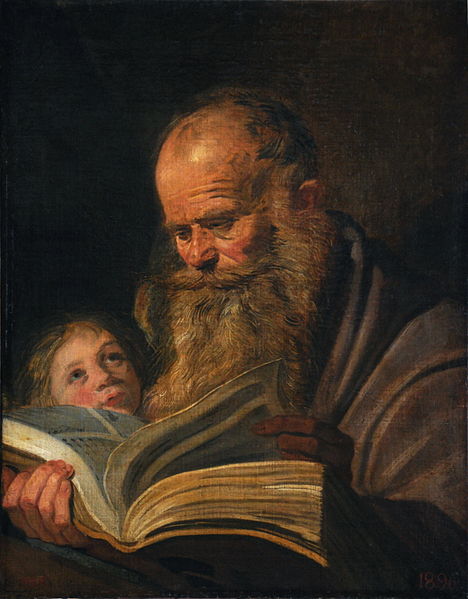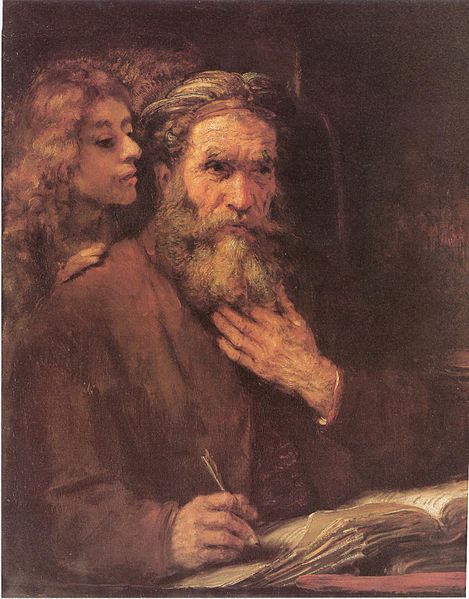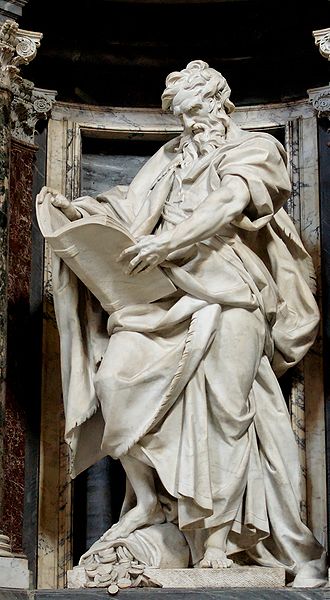<Back to Index>
- Apostle Matthew, 1st Century
PAGE SPONSOR



Matthew the Apostle (מַתִּתְיָהוּ Mattityahu or מתי Mattay "Gift of YHVH"; Greek: Ματθαῖος, Matthaios; also known as Saint Matthew) was, according to the Bible, one of the twelve Apostles of Jesus and one of the four Evangelists.
Among the early followers and apostles of Jesus, Matthew is mentioned in Mt 9:9 and Mt 10:3 as a former tax collector from Capernaum who was called into the circle of the Twelve by Jesus. He is also named among the number of the Twelve, but without identification of his background, in Mk 3:18, Lk 6:15 and Acts 1:13. He is called Levi, son of Alpheus, in Mk 2:14 and Lk 5:27. He may have collected taxes from the Hebrew people for Herod Antipas. Matthew was called by Jesus of Nazareth to be one of the Twelve Disciples. According to the New Testament he was one of the witnesses of the Resurrection and the Ascension.
Matthew was a 1st century Galilean (presumably born in Galilee, which was not part of Judea or the Roman Iudaea province) and the son of Alpheus. During the Roman occupation (which began in 63 BC with the conquest of Pompey), Matthew collected taxes from the Hebrew people for Herod Antipas, the tetrarch of Galilee. His tax office was located in Capernaum. Jews who became rich in such a fashion were despised and considered outcasts. However, as a tax collector he would have been literate in Aramaic and Greek.
It was in this setting, near what is today Almagor, that
Jesus called Matthew to be one of the Twelve Disciples. After his
call, Matthew invited Jesus home for a feast. On seeing
this, the Scribes and
the Pharisees criticized Jesus for eating with tax
collectors and sinners.
This prompted Jesus to answer, “I came not to call the
righteous, but sinners” (Mark 2:17)
New Testament records that as a disciple, he followed Jesus, and was one of the witnesses of the Resurrection and the Ascension. Afterwards, the disciples withdrew to an upper room (Acts 1:10-14) (traditionally the Cenacle) in Jerusalem. The disciples remained in and about Jerusalem and proclaimed that Jesus was the promised Messiah.
In the Babylonian Talmud (Sanhedrin 43a) "Mattai" is one of five disciples of "Jeshu."
Later Church fathers such as Irenaeus (Against Heresies
3.1.1) and Clement of Alexandria claim that Matthew
preached the Gospel to the Jewish community in Judea,
before going to other countries. Ancient writers are not
agreed as to what these other countries are. The Roman Catholic
Church and the Orthodox Church each hold the tradition
that Matthew died as a martyr. The tradition placing the
composition of Matthew's Gospel "fifteen" years after the
ascension is very late Nicephorus
Callisti (14th Century) and the Paschal Chronicle (17th
Century).
Although the first of the Synoptic Gospels is technically anonymous, traditionally the Gospel of Matthew was held to be written by the apostle. As a government official in Capernaum, in "Galilee of the Gentiles", a tax collector would probably have been literate in both Greek and Aramaic. Greek was the language used in the market place. Some early church fathers recorded that Matthew originally wrote in "Hebrew", but still regarded the Greek text as canonical.
Many scholars today, such as Raymond E. Brown, believe
that "canonical Matt[hew] was originally written in Greek
by a non eyewitness whose name is unknown to us and who
depended on sources like Mark and Q", a theory known as
Markan priority. However some scholars, notably Craig
Blomberg, disagree variously on these points.
The more traditional interpretation of the Synoptic
Gospels posits a Matthean priority, most notably in the
Augustinian hypothesis after one of the earliest and most
notable proponents Augustine of Hippo. This position once
held with veritable consensus in the Medieval church has
since waned, but still has several proponents.
In the 3rd century Jewish - Christian Gospels attributed to Matthew were used by Jewish - Christian groups such as the Nazarenes and Ebionites. Fragments of these gospels survive in quotations by Jerome, Epiphanius and others. Most academic study follows the distinction of Gospel of the Nazarenes (26 fragments), Gospel of the Ebionites (7 fragments), and Gospel of the Hebrews (7 fragments) found in Schneemelcher's New Testament Apocrypha. Critical commentators generally regard these texts as having been composed in Greek and related to Greek Matthew. A minority of commentators consider them to be fragments of a lost Aramaic or Hebrew language original.
The Infancy Gospel of Matthew is a 7th century compilation of three other texts: the Protevangelium of James, the Flight into Egypt and the Infancy Gospel of Thomas.
Origen said the first Gospel was written by Matthew. This Gospel was composed in Hebrew near Jerusalem for Hebrew Christians and translated into Greek, but the Greek copy was lost. The Hebrew original was kept at the Library of Caesarea. The Nazarene Community transcribed a copy for Jerome which he used in his work. Matthew's Gospel was called the Gospel according to the Hebrews or sometimes the Gospel of the Apostles and it was once believed that it was the original to the Greek Matthew found in the Bible. However this has been challenged by modern biblical scholars.
Jerome relates that Matthew was supposed by the Nazarenes to have composed their Gospel of the Hebrews though Irenaeus and Epiphanius of Salamis consider this simply a revised version canonical Gospel. This Gospel has been partially preserved in the writings of the Church Fathers, said to have been written by Matthew. Epiphanius does not make his own the claim about a Gospel of the Hebrews written by Matthew, a claim that he merely attributes to the heretical Ebionites.
The Quran speaks
of Jesus's disciples but does not mention their names,
instead referring to them as "helpers to the work of God".
Muslim exegesis and Qur'an commentary, however, names them
and includes Matthew among the disciples. Muslim exegesis
preserves the tradition that Matthew, with Andrew, were
the two disciples who went to Ethiopia to preach the
message of God.
Matthew is recognized as a saint in the Roman Catholic, Eastern Orthodox, Lutheran and Anglican churches. (See St. Matthew's Church.) His feast day is celebrated on 21 September in the West and 16 November in the East. (For those churches which follow the traditional Julian Calendar, 16 November currently falls on 29 November of the modern Gregorian Calendar). He is also commemorated by the Orthodox, together with the other Apostles, on 30 June (13 July), the Synaxis of the Holy Apostles. His relics are preserved in the Salerno Cathedral in Italy.
Like the other evangelists, Matthew is often depicted in Christian art with one of the four living creatures of Revelation 4:7. The one that accompanies him is in the form of a winged man. The three paintings of Matthew by Caravaggio in the church of San Luigi dei Francesi in Rome, where he is depicted as called by Christ from his profession as gatherer, are among the landmarks of Western art.